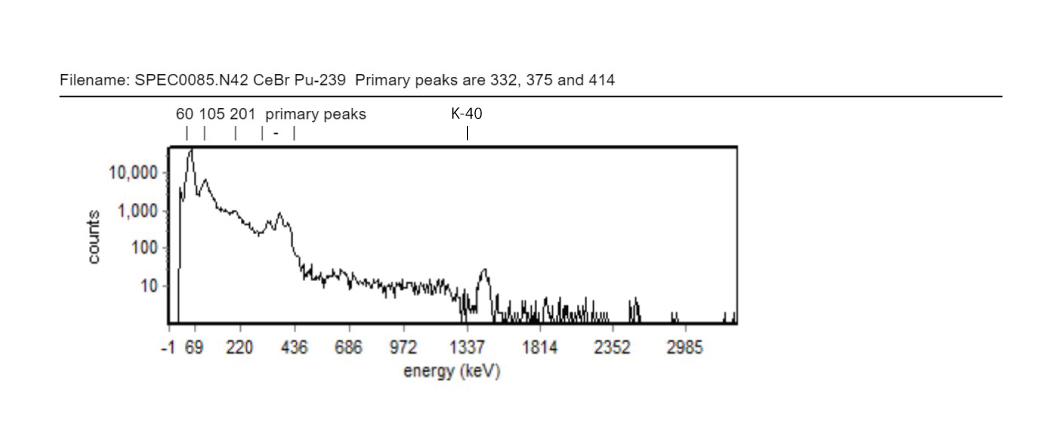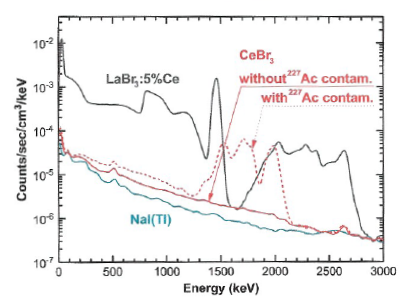July 26th, 2022 - The Performance of CeBr3 Detectors
High resolution scintillation detectors are now offering improved performance with lower intrinsic background. Standard cerium bromide (CeBr3) detectors are now available from BNC in 3x3 inch encapsulated sizes with greatly improved sensitivity and efficiency. This paper discusses the merits of CeBr3 from the standpoint of energy resolution and reduction of intrinsic background from 227Ac contamination.
Detector Resolution
CeBr3 detectors have several advantages over lanthanum bromide (LaBr3) detectors even though LaBr3 is widely accepted as the high-resolution scintillation detector. LaBr3 boasts 3% resolution at 662 keV and CeBr3 gives a resolution of about 4% at 662 keV. This allows both detectors to achieve good separation of the 609 keV 214Bi peak from the 662 keV 137Cs peak (which cannot be accomplished with NaI(Tl) detectors). Generally the ability to resolve spectra at high energies can be accomplished quite well with NaI(Tl). Resolving lower energy spectra of uranium (U) and plutonium (Pu) is important and it is this lower energy region in which the resolution of CeBr3 out performs that of LaBr3 [1]. This is noted when observing the 239Pu spectrum as shown in Fig. 1. The primary 239Pu peaks (332, 375 and 414 keV) stand out clearly with CeBr3. Also the X-rays at ~105 keV and the 201 keV gamma line are more pronounced with CeBr3. The low energy lines of weapons grade uranium are also better resolved with CeBr3. At even lower energies the resolution of LaBr3 continues to fall off dramatically such that the resolution of the 60 keV energy line of 241Am is worse than NaI(Tl).

Intrinsic Background
Typical background for CeBr3 detectors is primarily from 227Ac (parent nucleus is 235U). This contribution to the background from the 227Ac contamination is approximately 0.02 counts/sec/cm3 [2]. The concentration of 227Ac atoms per Ce atoms is of the order of 4x10-16. Even though this is a small amount of contamination it does represent a significant contribution to the background, especially in the 1.2 to 2.2 MeV region of the energy spectrum as seen in Fig. 2. Ac, Ce and La are all chemically homologous elements and therefore extremely difficult to separate one from the other. Through selection of material being screened before processing, the 227Ac background can now be essentially eliminated (about 0.001 counts/sec/cm3 [2]). Also seen in Fig. 2 is the much higher background in the LaBr3 detectors. In addition to the 227Ac there is significant contamination from 138La which is responsible for a very high background near 32 keV and continuing up to the 1461 keV region. Another region of background in LaBr3 begins at about 1520 keV through 2800 keV. This is from natural uranium (primarily the 214Bi daughter) giving CeBr3 an order of magnitude higher sensitivity than LaBr3 in this region of the spectrum. The reason this is so important is that detection of weapons grade Pu and weapons grade U relies on the detection of the 2615 keV energy line to verify its presence. Depending on the activity and the distance to the source, a longer acquisition may be necessary for verification. Therefore, it is not only important to have the highest sensitivity at this energy for CeBr3 (a factor of 10 improvement) but high background in this region for LaBr3 could mislead first line responders with a false positive for weapons grade material.

References
[1] Comparison of LaBr3: Ce and NaI(Tl) Scintillators for Radio-Isotope Identification Devices, B. D. Milbrath, et. al., Pacific Northwest National Laboratory (PNNL)
[2] P. Schotanus, et al., Nuclear Instruments and Methods in Physics Research A 729 (2013) 596-204
